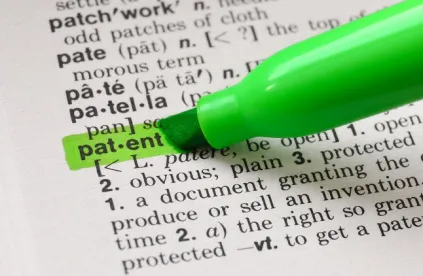Introduction
In two recent articles (see parts one and two of series), we discussed several aspects of a July 2019 Update that the Patent Trial and Appeal Board (PTAB) issued to the PTAB Trial Practice Guide.[i] This article completes that discussion, addressing motions for joinder, and procedures regarding remands and the PTAB’s default protective order.
1. Motions for joinder
A party may seek to join a proceeding by filing a motion within one month of the date of institution of the proceeding. The July 2019 Update lists identifies the following factors that the Board may consider in deciding a motion for joinder:
-
Why joinder is appropriate;
-
Whether the second petition (to be joined to the first) raises a new ground of unpatentability;
-
The impact on the cost and schedule of the first proceeding if joinder is granted; and
-
Whether granting joinder will add to the complexity of briefing and/or discovery.[ii]
The July 2019 Update also emphasizes that the PTAB may exercise discretion under 35 U.S.C. § 315(c) to join a petitioner to a proceeding in which it is already a party and to allow joinder of new issues into an existing proceeding, citing extensively from the PTAB precedential opinion in Proppant Express Invs. v. Oren Techs.[iii]
For example, when an otherwise time-barred petitioner requests same party and/or issue joinder, the Board may exercise its discretion to permit joinder, but will do so only where fairness requires it and to avoid undue prejudice to a party. The PTAB says that it expects to exercise such discretion only in “extremely limited circumstances”.[iv] The stage and schedule of an existing inter partes review might also make joinder to that proceeding inappropriate.[v] In addition, the General Plastic factors may come into play in the PTAB’s exercising discretion to deny institution under 35 U.S.C. § 314(a).[vi]
Finally, the July 2019 Update cites statutes and rules permitting the Board to adjust the one-year statutory deadline for issuing a final written decision in the case of joinder.[vii] If the Board does decide to make such an adjustment, the Board will issue an order, making that adjustment, before the one-year statutory time period in the case to which the current petitioner is joined expires.[viii]
Joinder can be a valuable tool where another party already has a pending proceeding, and a petitioner wants to ensure that the proceeding continues in the event that the party involved in the proceeding settles. But where the petitioner previously filed an unsuccessful petition and now seeks to have a “fixed” petition joined to a proceeding, the PTAB will look closely at whether the petitioner is merely using the prior denial as a roadmap to fix the previous mistake. If that is what appears to be happening, the PTAB is likely to exercise discretion and deny the “fixed” petition, particularly if the “fixed” petition otherwise is out of time.
2. Remands
When a case that has been appealed comes back to the PTAB on remand, there may be specific instructions from the Federal Circuit on how to proceed with remand (e.g. whether to re-open the evidentiary record). In general, the PTAB intends to adhere to a six-month time limit in which to issue decisions on cases that the Federal Circuit has remanded.
Within ten business days of receiving a mandate from the Federal Circuit, the parties should contact the Board to arrange a conference call to discuss remand procedures, including but not limited to the following:
-
whether additional briefing is necessary, and if so, subject matter limitations on briefing and length of briefing;
-
briefing schedule, including whether the parties should file briefs concurrently or sequentially, and if sequentially, which party should open the briefing;
-
whether a second brief from either party should be permitted; and
-
whether either party should be permitted to supplement the evidentiary record, and if so, limitations, if any, on the type of additional evidence that will be submitted, and the schedule for submitting additional evidence, if any.[ix]
In deciding whether to permit additional briefing and additional evidence, the Board may take into account whether the parties already have had an adequate opportunity to address the remand issues with the existing record. Moreover, unless the Federal Circuit directs the Board to reopen the evidentiary record, a party seeking to re-open the evidentiary record will need to demonstrate inadequacy of existing evidence, and good cause why additional evidence is necessary. In most cases, there will be no further oral hearing, though introduction of additional evidence may warrant authorizing additional oral argument.[x]
The Board will not stay remand proceedings, even if there is a petition for certiorari to the US Supreme Court, absent a showing of good cause. But in deciding whether to stay on remand, the Board may consider whether the Supreme Court’s judgment would have an impact on the Board’s decision on remand.[xi]
If a party wants to submit new evidence in the remand proceeding, or stay the proceeding, the conference call with the Board after remand is important. It would be during that conference call that the party would make its showing of “good cause”.
3. Protective orders
The July 2019 Update provides two procedural changes regarding protective orders.
First, the Update clarifies that the Board does not enter a protective order by default. This is important because the original Trial Practice Guide provided for automatic entry of a default protective order.[xii] The 2018 Revised Trial Practice Guide changed that practice, stating,
“No protective order shall apply to this proceeding until the Board enters one.”[xiii]
Second, one or more parties must propose a protective order, and the Board must approve and enter it.[xiv] If the parties cannot agree on entry of a stipulated protective Order, the Board may enter the PTAB’s default protective order.[xv] Thus, the default protective order applies only if a protective order is proposed but agreement cannot be reached.
These procedural changes could be a trap for the unwary, as parties now have to take affirmative action to get a protective order entered before trying to submit anything under seal.
Conclusion
The July 2019 Update reflects the PTAB’s growing experience with post-issuance petitions and proceedings, and cites a number of opinions which the PTAB has designated as precedential or informative. As the PTAB’s Precedential Opinion Panel (POP), which has been in existence less than a year, designates more opinions, we should expect more updates to the Trial Practice Guide as the PTAB continues to streamline and codify its practices and procedures.
[i] Trial Practice Guide Update (July 2019), available at (July 2019 Update).
[ii] July 2019 Update, p. 42 (citing Kyocera Corp. v. Softview LLC, Case IPR2013-00004 (PTAB Apr. 24, 2013), slip op. at 4 (Paper 15)).
[iii] Case IPR2018-00914, slip op. at 3–4 (PTAB Mar. 13, 2019) (precedential).
[iv] July 2019 Update, p. 42, citing Proppant at 19.
[v] July 2019 Update, p. 43, citing Proppant at 19.
[vi] Id.
[vii] July 2019 Update, pp. 43-44.
[viii] July 2019 Update, p. 44, (citing Apple, Inc. v. Evolved Wireless LLC, Case IPR2016-00758 (PTAB Oct. 12, 2017) (Paper 44)).
[ix] July 2019 Update, p. 46.
[x] July 2019 Update, pp. 46-47.
[xi] July 2019 Update, p. 48.
[xii] 2012 Trial Practice Guide, p. 75.
[xiii] 2018 Revised Trial Practice Guide, p. 24.
[xiv] July 2019 Update, p. 6.
[xv] July 2019 Update, p. 50.




 />i
/>i

